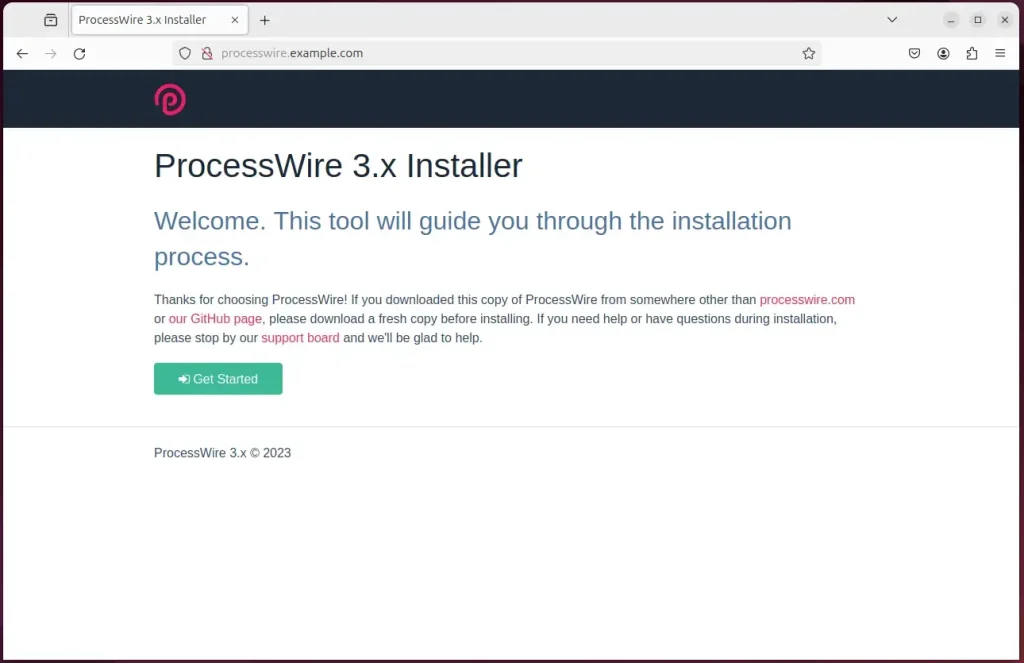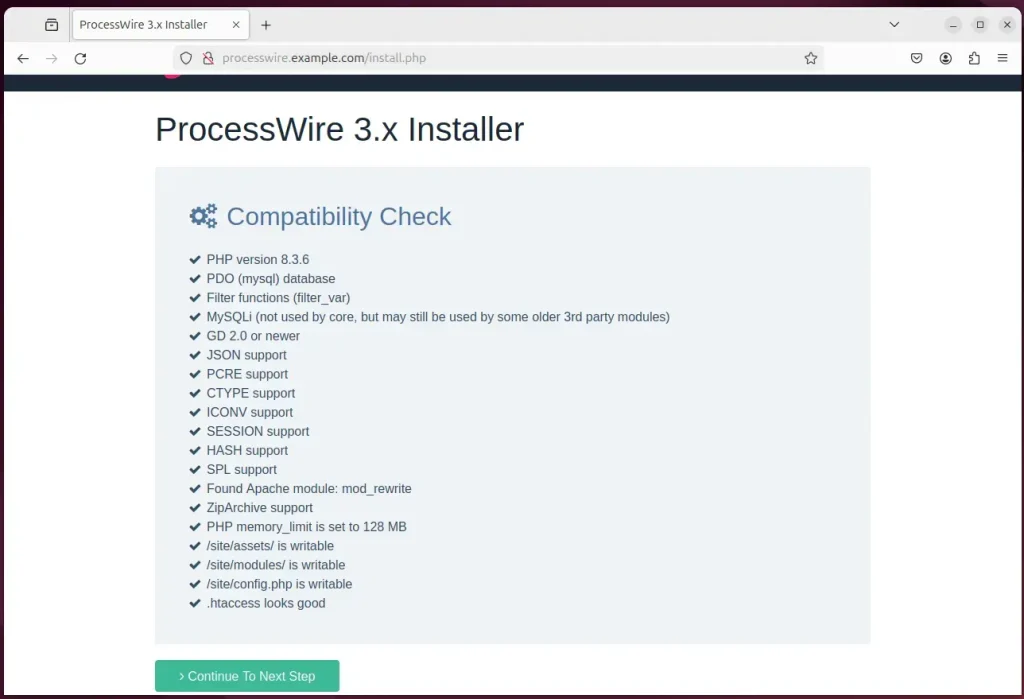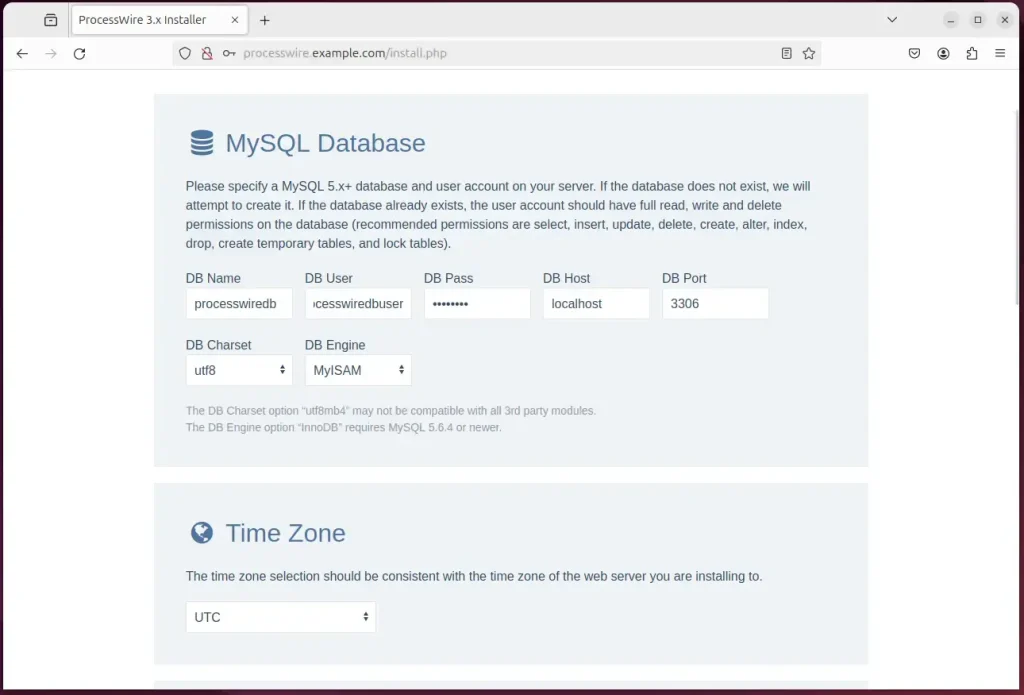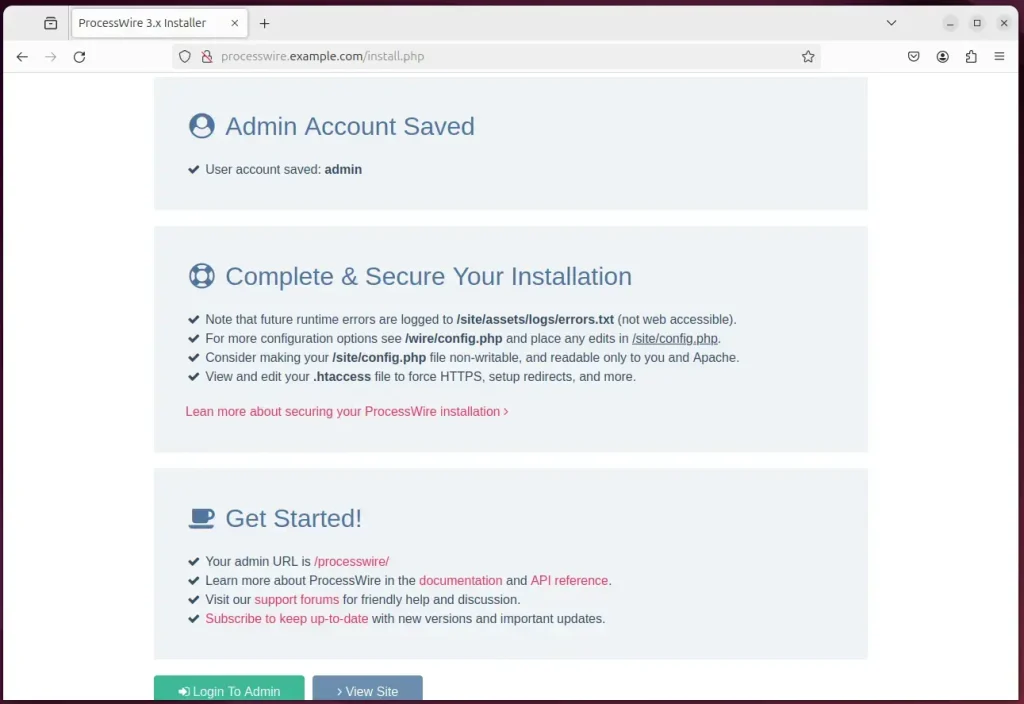This article explains how to install ProcessWire with Apache on Ubuntu 24.04.
ProcessWire is commonly installed with Apache on Ubuntu because Apache is a widely used web server compatible with ProcessWire. Ubuntu is a popular operating system, and many web developers prefer to use Apache on Ubuntu for hosting web applications.
This combination provides a stable and secure environment for running ProcessWire-powered websites and applications.
The steps below walk you through installing ProcessWire with Apache on Ubuntu 24.04.
Install Apache HTTP server on Ubuntu Linux
ProcessWire requires a web server. This post will install and use the Apache web server to run ProcessWire.
To do that, open the Ubuntu terminal and run the commands below to install the Apache web server.
sudo apt update
sudo apt install apache2
Once Apache is installed, the commands below can start, stop, and enable the Apache web server to start automatically when your server boots up.
sudo systemctl stop apache2
sudo systemctl start apache2
sudo systemctl enable apache2
You can test that the Apache web server is running by opening your web browser and browsing to the server’s local host or IP address.
http://localhost

When you see the Apache2 Default Page, it means the Apache HTTP server is successfully installed.
Additional help on installing Apache on Ubuntu is in the link below.
How to install Apache on Ubuntu
Install MariaDB database server on Ubuntu Linux
The next component that is required to run ProcessWire is a database server. This post will install and use the MariaDB database server to run ProcessWire.
To install and use the MariaDB database server, use the instructions below.
Open the Ubuntu terminal and run the commands below to install the MariaDB database server.
sudo apt update sudo apt install mariadb-server
Once the MariaDB database server is installed, use the commands below to stop, start, and enable the MariaDB server to start automatically when the server boots.
sudo systemctl stop mariadb sudo systemctl start mariadb sudo systemctl enable mariadb
Run the following commands to validate and test if the MariaDB database server is installed successfully.
sudo mariadb
Once you run the commands above, it will log you onto the MariaDB console and display a message similar to the one below.
Welcome to the MariaDB monitor. Commands end with ; or \g. Your MariaDB connection id is 32 Server version: 10.11.2-MariaDB-1 Ubuntu 23.04 Copyright (c) 2000, 2018, Oracle, MariaDB Corporation Ab and others. Type 'help;' or '\h' for help. Type '\c' to clear the current input statement. MariaDB [(none)]>
The message tells you that the server is installed successfully.
Additional help on installing MariaDB.
Create a ProcessWire database
Upon successful installation of the MariaDB database server, create a blank database on the server specifically for the ProcessWire application.
As part of the setup, we will create a database named ‘processwiredb‘ and a corresponding user account called‘ processwiredbuser. ‘
Finally, we’ll grant the processwiredbuser full access to the processwiredb database.
All the database steps above can be done using the commands below:
But first, log on to the MariaDB database server:
sudo mariadb
Then run the commands below to complete the steps:
CREATE DATABASE processwiredb CHARACTER SET utf8mb4 COLLATE utf8mb4_general_ci;
CREATE USER processwiredbuser@localhost IDENTIFIED BY 'type_your_password_here';
GRANT ALL ON processwiredb.* TO processwiredbuser@localhost WITH GRANT OPTION;
FLUSH PRIVILEGES;
exit
Ensure to replace ‘type_your_password_here ‘with your password.
Install PHP on Ubuntu Linux
The last component you will need to run ProcessWire is PHP. The ProcessWire application is PHP-based and supports the latest versions of PHP.
Run the commands below to install PHP.
sudo apt install php libapache2-mod-php php-intl php-mysql php-curl php-cli php-zip php-xml php-gd php-common php-mbstring php-xmlrpc php-json php-sqlite3 php-soap php-zip
Additional help on installing PHP
How to install PHP on Ubuntu Linux
Download ProcessWire files
Let’s begin the straightforward process of downloading and configuring the ProcessWire files on Ubuntu Linux.
First, navigate to the /tmp/ directory and download ProcessWire files. After unzipping the file, move the content into the ProcessWire folder in the Apache root directory.
The final step is to change the permissions. This will allow the Apache web server to safely interact with the files, ensuring a secure environment for your ProcessWire installation.
cd /tmp/
wget https://github.com/processwire/processwire/archive/master.zip
sudo unzip master.zip
sudo mv processwire-master /var/www/processwire
After extracting ProcessWire content, you download a site profile. Site profiles can be found at the link below.
Before ProcessWire 3.0.191, these site profiles were bundled with the ProcessWire core. They have been moved out of the core to reduce the core download size and are now available for separate downloads.
Download a site profile you want to use from the link above. Then, extract and copy the site profile files into the ProcessWire directory in your web root. Replace the name part of site-name with the name of the profile, i.e. site-regular or site-languages, etc.
Run the command below to download the default beginner’s site profile. Unzip the file and copy it to the ProcessWire root folder.
wget https://github.com/processwire/site-beginner/archive/refs/heads/main.zip
unzip main.zip
sudo cp -rf site-beginner-main /var/www/processwire/site-benginner
sudo chown -R www-data:www-data /var/www/processwire/
Once all the steps are done, configure the Apache webserver to serve the ProcessWire content.
Run the commands below to create an Apache virtual host file for ProcessWire.
sudo nano /etc/apache2/sites-available/processwire.conf
Then, copy and paste the content block below into the Apache server block.
<VirtualHost *:80>
ServerName processwire.example.com
ServerAlias www.processwire.example.com
ServerAdmin admin@example.com
DocumentRoot /var/www/processwire
<Directory /var/www/processwire/>
Options FollowSymlinks
AllowOverride All
Require all granted
</Directory>
ErrorLog ${APACHE_LOG_DIR}/error.log
CustomLog ${APACHE_LOG_DIR}/access.log combined
</VirtualHost>
Save the file.
Then, run the commands below to enable the virtual host and restart the Apache server.
sudo a2ensite processwire.conf
sudo a2enmod rewrite
sudo systemctl restart apache2
Setup Let’s Encrypt SSL/TLS for ProcessWire
You may want to install an SSL/TLS certificate to secure your ProcessWire site. Secure your ProcessWire installation with HTTPS from Let’s Encrypt.
Please read the post below for additional resources on installing and creating Let’s Encrypt SSL certificates for Apache.
How to set up Let’s Encrypt SSL certificate for Apache on Ubuntu Linux
Once you have restarted the Apache web server, open your browser and browse to the server hostname or IP address defined in the Apache server block.
http://processwire.example.com
A ProcessWire installation wizard page should appear. Click on Get Started to start the installation.

Next, select the installation profile and continue.

On the next screen, check to see if all requirements are met and continue.

Next, type in the database name, account, and password and continue.

Next, type in the admin account, email address, and password on the next screen.

Your ProcessWire site should be set up and ready to use.

That should do it!
Conclusion:
- This tutorial covered the step-by-step process of setting up a ProcessWire site on Ubuntu 24.04 with Apache support.
- Following the outlined instructions, you can create a stable and secure environment for hosting ProcessWire-powered websites and applications.
- Apache as the web server and MariaDB as the database server, along with the installation of PHP, provides a comprehensive platform for running ProcessWire effectively.
- Additionally, the tutorial includes guidance on configuring Apache virtual hosts and setting up Let’s Encrypt SSL/TLS certificates for enhanced security.
- If you encounter any issues or require further assistance, please utilize the comments section for support and clarification.

Leave a Reply Cancel reply